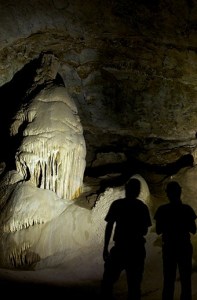 Our upcoming destination is one that started as a quest for cities lined with goldsmith shops, grand homes, and doorways studded with emeralds and turquoise. And even though these places turned out to be real only in tall tales, today we will discover the rich history and culture that evolved due to the expedition to find them. Kids, grab your Coronado National Memorial Junior Ranger Guide from the GPO Bookstore. We’re off to Cochise County, Arizona to discover Coronado National Memorial!
Our upcoming destination is one that started as a quest for cities lined with goldsmith shops, grand homes, and doorways studded with emeralds and turquoise. And even though these places turned out to be real only in tall tales, today we will discover the rich history and culture that evolved due to the expedition to find them. Kids, grab your Coronado National Memorial Junior Ranger Guide from the GPO Bookstore. We’re off to Cochise County, Arizona to discover Coronado National Memorial!
In February of 1540, Francisco Vázquez de Coronado, who had served as a prominent member of the Mexico City council, left Compostela in Mexico. Along with him were 339 soldiers, a few Franciscan priests, and more than 1,100 Indian allies and slaves. Their mission? Discover the Cities of Cibola, which were believed to be bubbling over with gold, and claim them for Spain. Members of the expedition traveled along the San Pedro River, through deserts, and over mountains. With them, they brought more than 1,500 animals, such as horses, sheep, pigs, and cattle. They walked for two years, never to find the fabled cities. However, the arrival of Coronado and his armed expedition led to profound cultural change, which can still be observed today. Coronado, the soldiers, and the priests taught Spanish to the indigenous people of the region. Coronado’s expedition might not have led to the discovery of cities dripping in diamonds. But, it led to the later Spanish colonization of Southwest America, creating the Hispanic-American culture that lives on today.
First things first. Let’s explore the Memorial on a nature walk. Follow the path and count your steps to get a sense of just how far the expedition members walked when they made the two-year trek close to 4,000 miles. Keep an eye out for wildlife! Coronado National Memorial has 55 different kinds of mammals, including baby bats and black bears. As for plants, we might spot Yucca, Manzanita, Ocotillo, Agave, and more. Open your booklet to see what they look like and mark them as we go.
Next, we’re climbing 500 feet uphill to Coronado Cave! Historians believe that the Coronado Expedition might have sent exploring parties into the Huachuca Mountains where there are caves. Junior Rangers, open your booklets. Be ready to identify and sketch stalactites (these hang from the ceiling), stalagmites (these rise from the cave floor), and columns (where stalactites and stalagmites meet together).
Everyone pack in the van. We’re driving to the trailhead of Montezuma Pass. In your booklet, add a checkmark next to animal tracks you see. We’re looking for the traces of Turkey Vultures, White-Tailed Deer, Spiny Lizards, Coatis, and even Mountain Lions!
Once we hit the visitor center, we’ll get the opportunity to touch and feel some clothing items similar to those worn by members of the Coronado Expedition. In your booklet, write down how things feel when you pick them up. Were they light or heavy? What would these items protect you from on an expedition? At the Touch Table in the visitor center, touch the skulls and tracks of animals that are common in Coronado National Memorial.
Now, it’s time to mail a postcard to someone back home. Open your booklet for one that’s already available and ready to send! Tell the recipient of the postcard what your favorite part of visiting the National Memorial was.
The final and perhaps most crucial activity in this booklet is to complete the National Park Service Arrowhead, which represents the values that are protected by the National Park Service. In it, draw pictures of things you saw at Coronado National Memorial that you think should be protected.
We hope you enjoyed everything at Coronado National Memorial and all the fun activities in the National Park Service booklet. Stay tuned for more Summer Travels, and search “summer travel” on this blog to visit several other amazing national parks.
The GPO Online Bookstore – Easy Access to Federal Publications
HOW DO I OBTAIN THIS RESOURCE?
Sign up to receive promotional bulletin emails from the US Government Online Bookstore.
Shop Online Anytime: You can buy a vast majority of eBooks or print publications —with FREE Standard Shipping worldwide— from the U.S. Government Online Bookstore at https://bookstore.gpo.gov.
- Click here to purchase Coronado National Memorial Junior Ranger Guide
- Explore more publications within our Travel, Tourism and Recreation collection
Visit our Retail Store: To buy or order a copy of any print editions from this collection at GPO’s retail bookstore at 710 North Capitol Street NW, Washington, DC 20401, open Monday–Friday, 8 a.m. to 4 p.m., except Federal holidays, Call (202) 512-0132 for information or to arrange in-store pick-up(s).
Order by Phone or Email: Call our Customer Contact Center Monday through Friday, 8 am to 4:30 pm Eastern (except US Federal holidays). From US and Canada, call toll-free 1.866.512.1800. DC or International customers call +1.202.512.1800. Email orders to ContactCenter@gpo.gov
Visit a Federal depository library: Search for U.S. Government publications in a nearby Federal depository library. You can find the records for most titles in GPO’s Catalog of U.S. Government Publications.
Find more than a million official Federal Government publications from all three branches at www.govinfo.gov.
About the author: Blogger contributor Cat Goergen is the PR Specialist in GPO’s Public Relations office.




 Posted by Trudy Hawkins
Posted by Trudy Hawkins 




